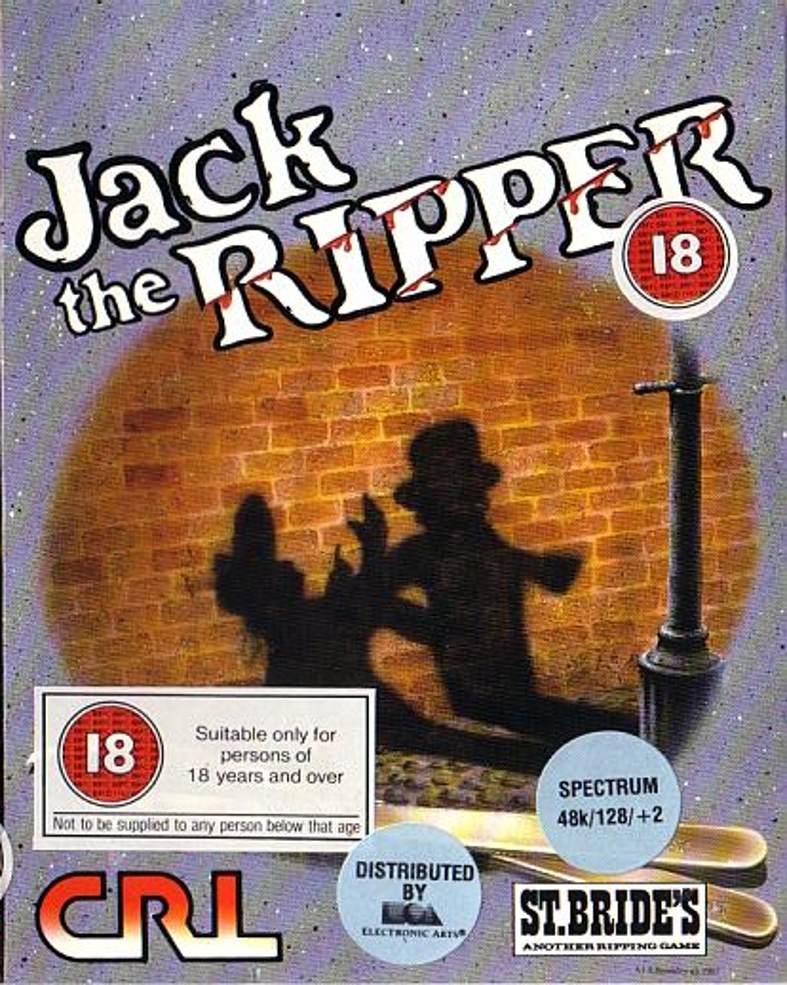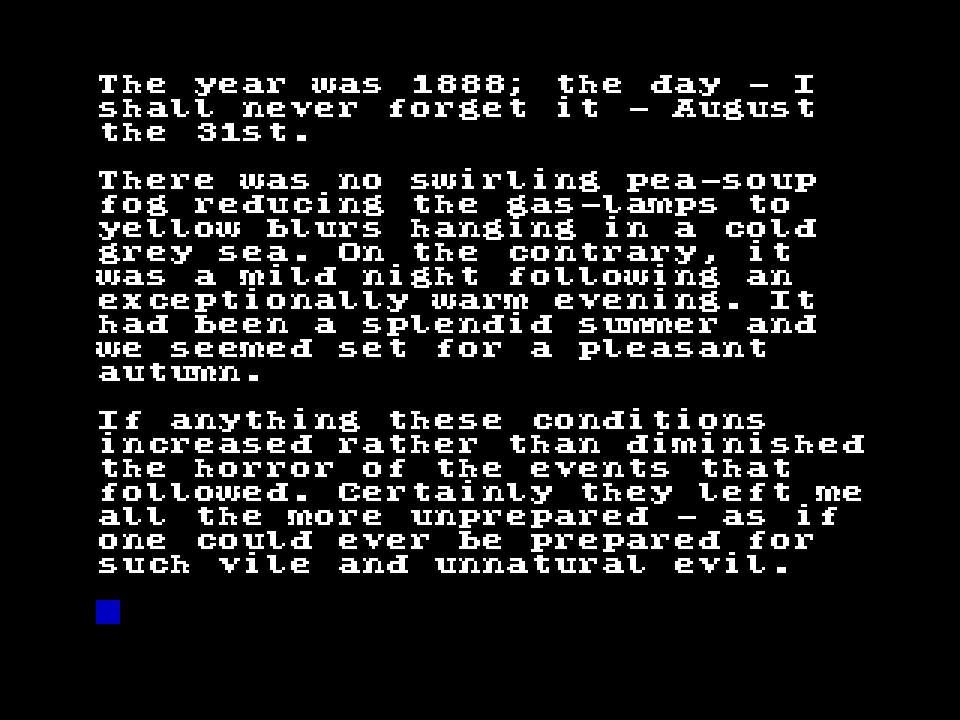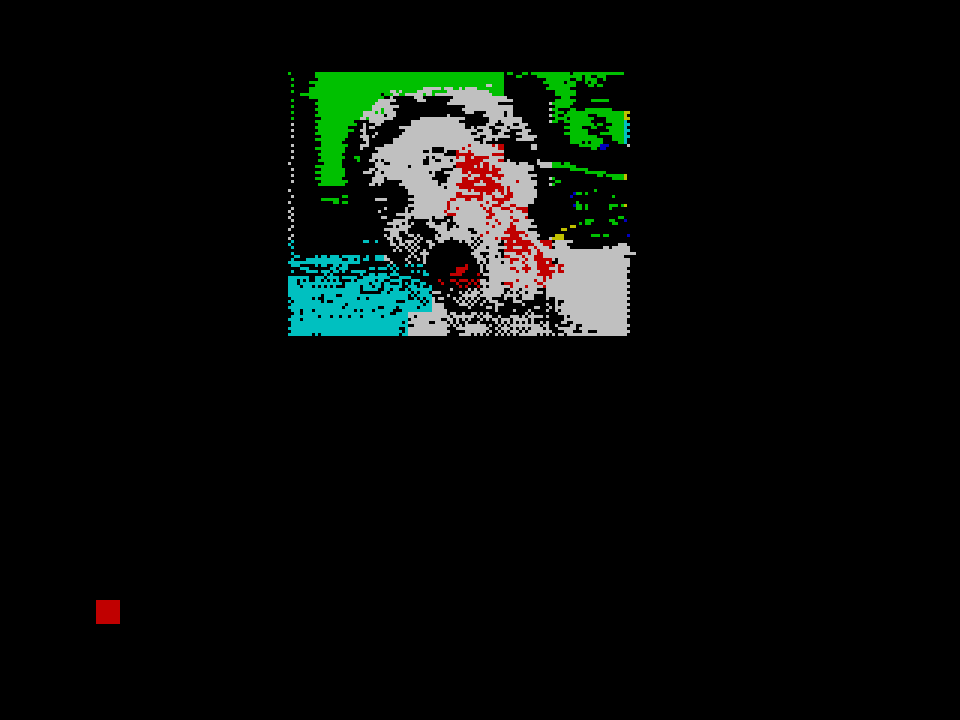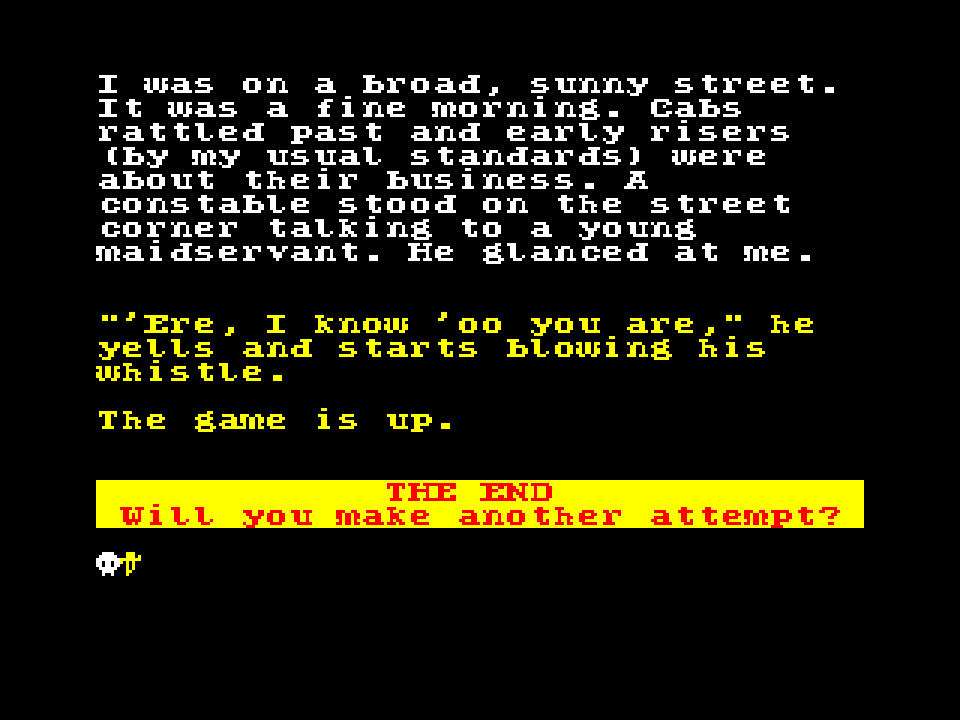Jack The Ripper Review

There were all these warnings for graphic content… But none for the weirdly intriguing plot… Or that the game does its damnedest to crawl under your skin…
Everything depicted in St. Bride’s School’s text adventure about the 1888 East End murders is of course 100% true… Or is it…?!
STORY
Not exactly countless, but many are the works of fiction that were inspired by certain events that happened in London, 1888. This text adventure approaches the whole situation from quite a different angle – That the murders were not only inhuman acts of brutality, but that they had a far more sinister purpose. The game takes this idea and runs with it until the very last moment. And it’s one hellish and one hell of a fascinating trip with a protagonist who not only comes to doubt his sanity, but his very existence.
And it all starts with one unbelievably bad August night in Buck’s Row.
THE GAME
Someone has just started slicing and dicing prostitutes in the alleys and backyards of Whitechapel. The protagonist, i.e., you, takes notice of a shady character before almost literally stumbling upon a dead woman in a badly lit back alley. She has been cut open by some obvious maniac, and the body is barely cold. At the crime scene, you find the murder weapon (A knife.) and a note with the address to a lady who evidently tried to warn the woman.
It’s just bad luck that you’re spotted in the area and that a copper gets a good look at you when you try to run away. The next thing you know, you’re the prime suspect. But at least you know you’re not the ripper. But this is where nightmares about the murders start plaguing your sleep and where your sanity starts to fold. And that’s also the beginning of a journey that will cost you – To say the least!
Jack The Ripper is in three parts. The first part has you trying to get away from the police and avoiding getting caught since everybody thinks you’re the murderer. This is the scenario for a couple of clever puzzles. The goal is to follow up certain clues from the crime scene. You’d think that you’re followed by nothing but bad luck in this game, but that’s just before the metaphysical aspects and the out of body experiences enter the plot in a very clever way. (And even then, we haven’t even talked about the logistic difficulties in such a scenario!)
It’s no Spoiler, but Jack himself doesn’t appear in the game (That means: There are no direct confrontations.) more than he would do in a story where he is neither caught nor identified. This adventure isn’t about hunting down the perpetrator. As for the identification of Jack, I won’t spoil anything. (Even if the case was merely and approximately 100 years old when this game was released.) But this game takes everything as far as it can in a very unexpected way in the third part. The plot is at all time connected to the murders, but it also explains the motive behind them and, as mentioned, the reason for the fear generated among the citizens as well as how the murders were connected beyond the fact that they were done by the “Ripper”.
CONTENT
CRL’s third text adventure with a BBFC classification went the whole nine yards. It was the first computer game to get the 18 rating. (Instead of 15, like Rod Pike’s Dracula and Frankenstein.) St. Bride’s School made sure to include some fucking horrifying descriptions around the murders, but also some graphic imagery for maximal effect. Of course, the images are small and not very detailed, but one’s imagination always manage to make them worse in combination with the text. Either way, that was enough to grant the highest rating normally reserved for motion pictures.
Jack The Ripper is one well-written game. The descriptions are of very high quality and could easily be a foundation for yet another novel. The English is of the kind where a non-native speaker like yours truly often has to look up words in the dictionary. Sure, the extremely puzzle-riddled part three has shorter descriptions for the metaphysical locations where very little happens, but once something happens, it’s harrowing. (To put it mildly.) The game is also narrated in past tense, asking things like: “What was I to do?” and “I considered my next move…” as it waits for the player’s input.
But what’s most surprising is how varied the different parts are. Even the second (and shortest) one manages to be a perfect glue between the first and last episode as it deepens the mystery and makes everything that doesn’t seem to make sense a whole lot clearer. Of course that’s before you’re thrown headlong into another nightmare. The plot is so well-constructed and fantastic that I wouldn’t be the least surprised if notes and expositions from it originated from someone who died and came back from the other side. (Someone who had an insight into the murders, for example a clairvoyant who perhaps tried to prevent everything from happening.) Nevertheless, it should be very intriguing should you wish to experience another angle to one of history’s most famous murder cases. Because for one reason or another, the killings ceased. The game even explains this part and makes it just as believable as the rest of it. (And if you can’t get behind the feeling of detachment from the plot in the third part, it too has its own explanation!)
This is not claiming that I could solve even half the puzzles in the game – Especially not in the last part. I had to write notes (I played it on the Commodore 64.), and peek at a walkthrough that didn’t contain any Spoilers. I am definitely no text adventure wizard, but someone who loves a challenge should find a proper one in Jack The Ripper. I believe it’s by far the best of the four classic horror-themed adventures that CRL released.
CONTROLS
The “text adventure”-kind, of course… The interpreter understands full sentences like “TAKE KNIFE AND EXAMINE IT”, “EXAMINE KNIFE CLOSELY”, as well as sentences with multiple instructions in one. The limitations aren’t quite that obvious as in other games based on the same engine. (Professional Adventure Writer) At quite a few occasions, you need to, for example, specify which of two similar objects you want to interact with.
GRAPHICS
By today’s standards, the various stills depicting a couple of Jack’s sliced up victims isn’t worse than any still from a horror movie ran through the Posterize-filter in Photoshop, but it’s the general atmosphere of the story, the descriptions, and the accompanying images that does the trick. (Meaning that the game is slightly better with the pictures than without them.) And for some reason, this version of Jack The Ripper has entirely different images (And a handful more exclusive ones.) than the Commodore 64 variant. In all their simplicity and limited on-screen dimensions (They’re just relatively small squares.), the graphics do cement the atmosphere.
SOUND
Grand and moving compositions grace… Some other game… This is a text adventure, remember? On the Speccy. But every keystroke generates a faint clicking sound that kind of reminds of typewriter. Which sounds soothing.
SUMMARY
“Warning: This game is not suitable for anyone of a nervous disposition.”, exclaims the title screen. And sure enough – The intricate prose messes with the mind as effectively as a good horror novel. And if you love this genre with nightmarish surrealism in the mix, you can’t go wrong with Jack The Ripper. It’s definitely not a beginner’s text adventure, but if you consider yourself a veteran in that field, you could find it very captivating. Just don’t demand Infocom-standards from the interpreter. Because it does get its occasional hiccups.
Jack The Ripper was written by St. Bride’s School who were behind classics such as Bugsy, The Very Big Cave Adventure, The Dogboy, The Snow Queen, and The Secret Of St. Brides. G.I. Games published the quite mysterious developer’s last two titles, Silverwolf and The White Feather Clock, as late as in 1992.
Developed by: St. Bride’s School
Published by: CRL
Version Reviewed: ZX Spectrum 48K
Genre: Text Adventure
Players: 1
Also Available On: Commodore 64, Amstrad CPC
Released: 1987







